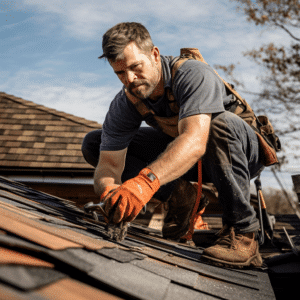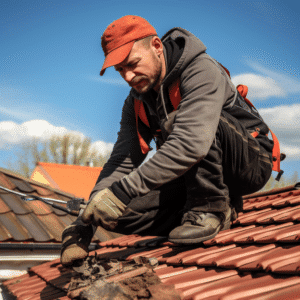Roof repairs: A damaged roof can be a homeowner’s worst nightmare! Leaks, water damage, and costly repairs can all result. Here, we explore steps to repair a damaged roof effectively and safely. Understanding the process is essential to protect your home.
Assess the damage first. Identify missing or broken shingles. Check for any signs of water leakage or structural issues. Gather the necessary tools and materials for the repair job.
Safety is key. Wear non-slip shoes and a hard hat. Use proper ladder safety techniques. Have someone help you during the repair.
Start by replacing any missing or broken shingles. Carefully remove them one at a time and secure new ones. Inspect and reinforce weakened or damaged areas of the roof structure. Apply sealant or roofing cement to prevent future leaks.
Did you know? Roof repairs can improve energy efficiency too. Adding insulation during repairs can reduce heating and cooling costs by providing better climate control.
Table of Contents
Assessing the Damage

Need to inspect your roof? Then you must conduct a professional evaluation of its state. Consider these 5 factors for assessing damage:
- Leaks
- Missing shingles
- Cracked tiles
- Sagging sections
- Water stains
It’s not just about the visible signs though. You must examine each factor closely for an accurate understanding of the problems. Roofing Magazine found that ignoring minor roof damage can lead to major & costly repairs later. So be sure to evaluate each factor properly, so you can deal with issues quickly and efficiently.
Gathering the necessary materials and tools
Assess the damage first! Take a close look and make note of what needs to be done.
Create a list of materials and tools needed; such as shingles, nails, tarps, adhesive, ladder, and safety gear.
Buy or borrow them from a store or pals.
Safety must be a priority when fixing the roof.
Get the stuff quickly and begin the repair.
Don’t miss out on protecting your house from further damage and potential leaks.
Your attention to this will bring peace of mind knowing that your roof is in good shape again.
Preparing the Work Area
For successful and safe roof repairs, prepping the work area is a must! Use these steps to create a well-organized environment that’ll make repairs a breeze.
- Clear the Area:
Sweep away anything loose, like leaves or branches, from the roof and nearby space. This stops potential accidents and makes it easier to get to the damaged area. Also, move any items that might block tools or slow down movement.
- Set Up Protective Measures:
Before the repair starts, protect yourself and surrounding property. Put tarps or drop cloths on the ground to collect falling stuff and protect the landscape below. Use safety ropes or harnesses too, making sure there’s an anchor point for security.
- Gather Essential Tools:
Having the right tools nearby saves time and effort. Get a stable ladder, protective gear (for example, gloves and goggles), roofing materials (like shingles or sealant), a hammer, nails, and a utility knife. Place everything in an easy-to-reach spot near the work area.
Safety should always be your priority when prepping the work area. With this thorough cleaning, protective measures, and gathering of tools, you’ll have a hazard-free space ready for repairs. This preparation decreases chances of accidents or delays.
Also, secure any loose gutters or downspouts close to the damaged area with brackets or supports. This stops more damage from strong winds or rains, before the repairs are finished.
To get even better prepared, get help from someone reliable. They can grab materials or give an extra hand when needed. This increases progress and helps with safety.
In conclusion, adequate work area preparation is essential before roof repairs can begin. Use these tips and add more precautions to create a safe and efficient space to restore the damaged roof.
Repair Methods
When it comes to roof repairs, you may need to do different things depending on the damage. Here are some repair methods to look into:
- Patch Repair: Fix small cracks or holes with roofing cement or sealant.
- Shingle Replacement: Replace individual broken or missing shingles.
- Reroofing: Extensive damage may require a new roof.
Make sure to inspect before deciding how to repair. Plus, talk to a professional roofer for tailored advice.
Don’t delay taking care of roof issues. Waiting can lead to more serious problems in the future. Take action now and protect your property from water damage, mold growth, and structural damage.
Keep your roof healthy and strong for many years to come. Do regular inspections and make timely repairs. This will protect your investment and give you peace of mind.
Step-by-Step Instructions
Assess the damage. Inspect your roof for signs like missing shingles or leaks. Note the areas that need repair.
Gather tools and materials. Get a hammer, ladder, nails, and replacement shingles.
Repair the areas. Lift up the edges of the old shingle and slide it out. Put the new shingle in place and secure it with nails.
Check for other issues. Clogged gutters or improper ventilation can lead to more damage. Address them to prevent future issues and extend your roof’s lifespan.
History of roof repairs. Ancient civilizations like Mesopotamia and Egypt used roof repairs. Methods changed, but the goal stayed the same – protect homes from nature.
Safety Precautions
Safety is top priority when repairing a roof. Taking the right steps not only keeps you healthy, but also helps the project succeed. Here are some safety tips to keep in mind:
- Wear hard hats, safety goggles, and non-slip shoes to protect from harm.
- Make sure ladders are strong and secure, and have someone hold it for support.
- Keep away from overhead power lines. Maintain a safe distance to avoid electrocution.
- Schedule work on the roof during good weather. Steer clear of rain, wind, and ice, which can cause accidents.
- Secure tools and materials; this keeps the workspace clean and prevents tripping.
Be mindful of special features of your roof as you work. Each roof is different, with fragile parts or complex designs. Knowing these details helps you spot potential dangers and take the right precautions.
The National Safety Council found that falls are one of the main causes of construction site injuries. So, safety should be the focus of any roof repair.
In conclusion, safety is key when repairing a roof. By following these measures and recognizing risks, you can make sure the project is safe for everyone involved.
Maintenance and Prevention Tips

It’s essential to keep your roof in tip-top shape. Here are some tips to help you:
- Inspect it twice a year – to catch any problems early.
- Gutters – make sure they’re unclogged. Otherwise, water can back up and damage the roof.
- Trim nearby trees – branches can scratch or harm it during a storm.
Plus, check for moss or algae growth. Use an eco-friendly cleaner and scrub lightly.
Pro Tip: Regular maintenance prevents damage, extending its lifespan.
Conclusion
Maintaining the structural integrity of your home requires roof repairs. To do so, follow this article’s step-by-step guide:
- Begin by assessing the damage and gathering materials.
- Patch any leaks or holes with roofing cement and a patching material.
- Secure loose shingles and replace severely damaged ones.
- Check the gutters and downspouts for blockages or damage.
- Address any underlying issues which caused the damage.
- Ensure proper ventilation and insulation in the attic to avoid moisture buildup.
- Clean the gutters and remove debris from the roof for regular maintenance.
- Consider hiring a professional roofer for complex repairs or replacements.
Safety is key, so use harnesses and sturdy ladders. Avoid working during inclement weather.
Lastly, inspecting the roof for signs of damage can prevent future costly repairs.
Frequently Asked Questions
1. How do I know if my roof is damaged?
If you notice water leaks, missing shingles, or sagging in your roof, these are signs that your roof may be damaged.
2. Can I repair the roof myself?
While it is possible to repair a damaged roof on your own, it is recommended to hire a professional for safety and to ensure a proper fix.
3. How much will roof repair cost?
The cost of roof repair varies depending on the extent of the damage and the materials needed. It is best to get a few quotes from roofing contractors for an accurate estimate.
4. How long does roof repair take?
The duration of roof repair depends on the extent of the damage and the weather conditions. A small repair may take a few hours, while a larger one can take several days.
5. Will my homeowner’s insurance cover roof repairs?
In most cases, homeowner’s insurance covers roof repairs if the damage is due to a covered peril such as a storm or falling tree. Review your policy or consult with your insurance provider for specific details.
6. How can I prevent future roof damage?
Maintaining your roof regularly, cleaning gutters, replacing damaged shingles promptly, and trimming overhanging trees can all help prevent future roof damage.